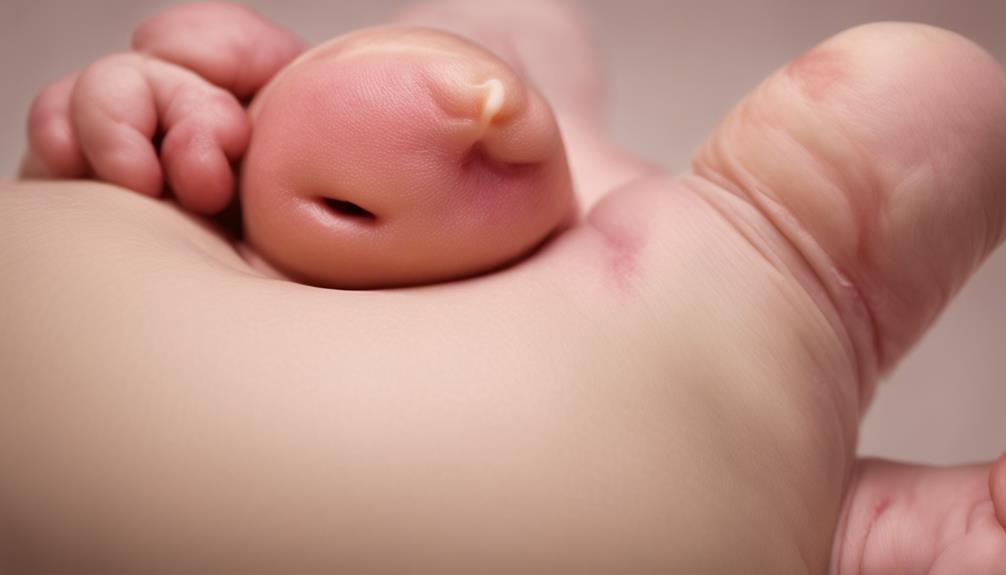As caregivers, our main objective is to provide the best possible care for our little ones, ensuring their health is a top priority from the start. When it comes to caring for a newborn’s umbilical cord stump, striking the right balance between cleanliness and health is crucial.
But what exactly does this entail, and how can we navigate this terrain effectively to promote our baby's health and comfort? Let's explore the essential steps and considerations involved in caring for your newborn's umbilical stump, guiding you through this vital aspect of early infancy with confidence and precision.
Key Takeaways
- Proper care prevents infections and aids in healing.
- Use mild baby cleanser and warm water for cleaning.
- Watch for signs of infection like redness and swelling.
- Keep the umbilical stump dry, exposed, and consult healthcare providers.
Importance of Belly Button Care
Proper care of a newborn's belly button is important for preventing infections and promoting healing. The umbilical cord stump, which is left after the cord is cut, requires special attention. Keeping the belly button clean and dry is vital for the best healing of this delicate area. It's important to avoid getting the stump wet and to make sure it's exposed to the air to aid in faster healing.
When caring for the belly button, gentle cleaning is key. Using a soft, clean cloth and warm water, gently wipe around the base of the cord stump. Avoid rubbing or pulling on the stump, as this can cause irritation and slow down the healing process. If you notice any signs of infection, such as redness, swelling, or discharge, it's important to contact your healthcare provider immediately for further guidance.
Supplies Needed for Care

To care for a newborn's belly button, gather mild baby cleanser, soft washcloths, warm water, and cotton pads. These supplies are essential for maintaining proper hygiene around the umbilical cord stump. Using mild baby cleanser helps keep the baby's belly button area clean without causing irritation.
Warm water and soft washcloths are gentle on the delicate skin, aiding in natural healing and preventing infections. Cotton pads are useful for drying the area thoroughly after cleaning, promoting best healing and the eventual falling off of the stump within 1-3 weeks.
It's important to avoid harsh chemicals or alcohol-based products as they can be too harsh for the baby's sensitive skin. Proper care, including keeping the area clean and dry, is key to preventing complications. For specific recommendations tailored to your baby's needs, consult your healthcare provider.
They can offer guidance on a care routine that suits your baby's belly button area, ensuring the best outcomes for your little one.
Step-by-Step Cleaning Instructions
When cleaning a newborn's belly button, gently dampen a soft washcloth with water for gentle cleansing. It's crucial to be delicate around the umbilical stump to prevent any discomfort for the baby. Here are the step-by-step cleaning instructions to help keep your baby's belly button area healthy and free from infection:
- Use Water and Soft Washcloth: Wet a soft washcloth with clean water. Make sure the water is warm but not too hot. Gently wipe around the area of the umbilical stump to remove any dirt or residue.
- Pat Dry and Allow to Air Dry: After cleaning, pat the area dry with a clean, soft towel. Let the belly button and the area around the stump air dry completely before putting on a diaper or clothing.
- Monitor for Signs of Infection: Keep a close eye on the belly button area for any signs of infection, such as redness, swelling, or discharge. If you notice any concerning symptoms, contact your healthcare provider for guidance.
Signs of Infection to Watch For

Keeping a close eye on your newborn's belly button is important to promptly identify any signs of infection that may arise. It's vital to be vigilant for any redness, swelling, tenderness, pus, or discharge with a foul odor around the umbilical stump area. Additionally, persistent bleeding or oozing from the belly button stump and the presence of fever or irritability in your newborn, along with belly button redness, could all be indicators of an infection that requires immediate attention to prevent complications.
| Signs of Infection | Description | Action Needed |
|---|---|---|
| Redness | Skin around stump is red | Monitor closely |
| Swelling | Area appears swollen | Consult healthcare provider |
| Tenderness | Belly button is sensitive | Seek medical advice |
| Pus/Discharge | Foul-smelling discharge | Contact healthcare provider |
If you notice any of these signs, do not hesitate to seek medical advice promptly to guarantee your newborn's belly button heals properly and stays healthy.
Additional Tips for Healing and Care
For best healing and care of your newborn's belly button, it's essential to maintain proper hygiene practices and follow these additional tips.
- Keep it Dry and Exposed: Ensuring the umbilical stump area remains dry and exposed to air can aid in faster healing after it falls off.
- Avoid Tight Clothing: Opt for loose-fitting clothing around the belly button to allow for proper air circulation and prevent any rubbing that could hinder the healing process.
- Consult Healthcare Professionals: It's important to consult healthcare professionals if you notice any signs of infection, persistent discharge, unusual swelling, or have any concerns about the healing progress. Prompt medical attention can prevent complications and guarantee your baby's belly button heals properly.
Frequently Asked Questions
How Do I Take Care of My Newborn's Belly Button?
We gently clean our newborn's belly button with water and a soft cloth, avoiding harsh cleansers to aid healing. Keeping it dry and monitoring for signs of infection is essential. If concerned, we consult a healthcare provider promptly.
Should I Clean My Baby's Belly Button After Cord Falls Off?
Yes, we should clean our baby's belly button after the cord falls off. Use gentle cleaning with water and a soft washcloth. Avoid harsh chemicals. Keep the area dry and monitor for signs of infection.
How Do I Know if My Baby's Belly Button Is Healing Properly?
We can tell if a baby's belly button is healing properly by observing for dryness and cleanliness. Look for scabbing or minor bleeding, and be vigilant for any redness, swelling, or foul odors. If concerned, seek medical advice promptly.
When Should I Worry About My Newborn's Belly Button?
If our newborn's belly button shows signs of infection, persistent bleeding, unusual discharge, or a bulge, we should seek medical advice promptly. Vigilant monitoring helps detect any issues early, ensuring our baby receives timely care for best health.
Conclusion
In summary, proper newborn belly button care is important for your baby's health and well-being.
Did you know that 10-20% of newborns develop an umbilical stump infection?
By following the steps outlined in this guide and being vigilant for signs of infection, you can help prevent complications and guarantee your baby's belly button heals properly.
Remember, always consult with your healthcare provider if you have any concerns. Your baby's health is worth it.







